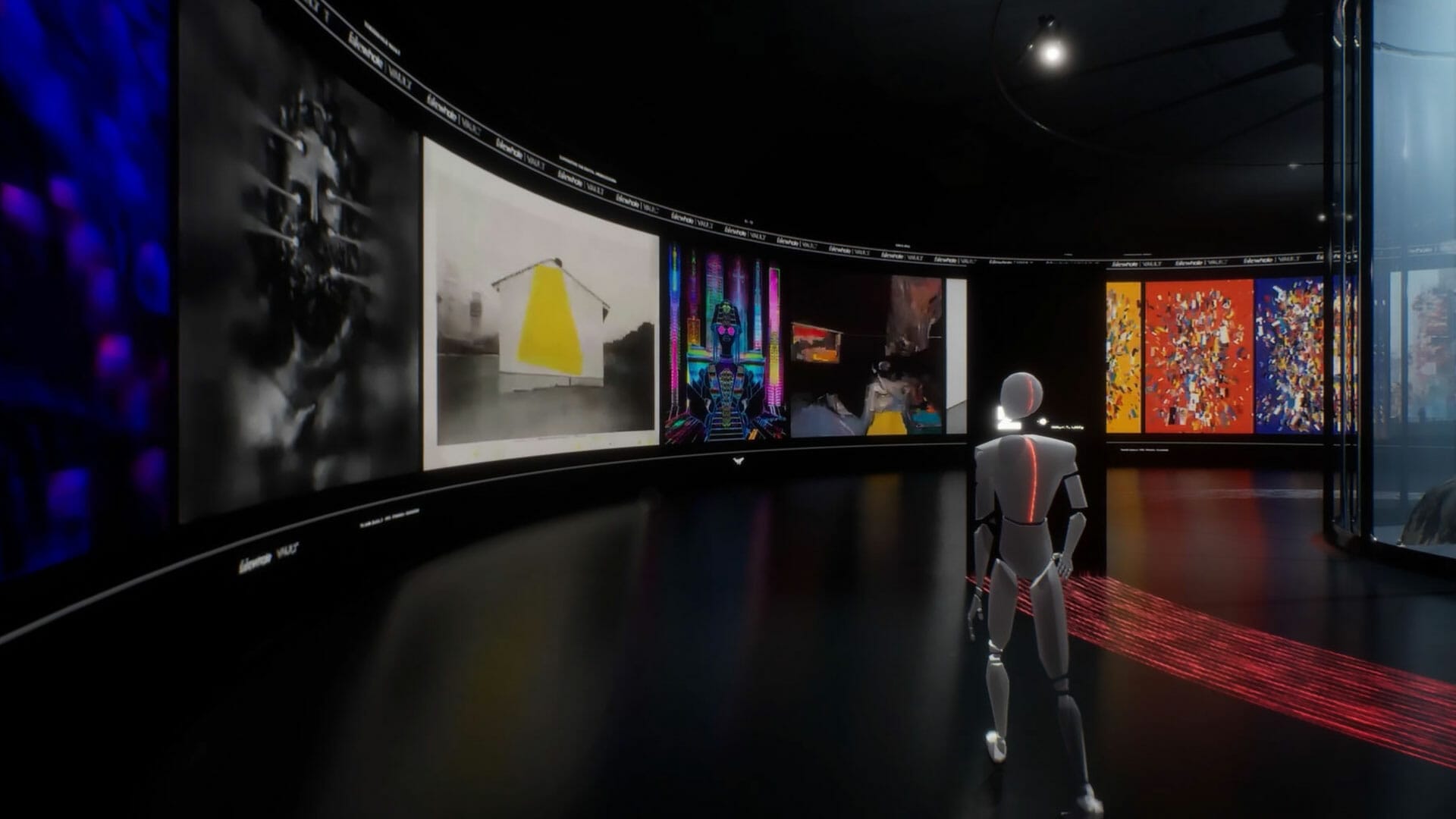
Fakewhale presents RIP HEN: A Tribute to Hic et Nunc
On November 11th, 2021, the digital art community witnessed the unforeseen closure of Hic Et Nunc (HEN): an experimental, open-source NFT platform, marking a turning point in the digital art world. Founded in March 2021 by Rafael Lima, HEN had rapidly become a celebrated hub for artists and collectors, renowned for its community-driven ethos and focus on art-centric marketplaces.
This abrupt shutdown, however, did not signify an end but rather a transformational moment that sparked a new chapter in digital art’s evolving narrative.
Fakewhale, active in the Tezos scene since the early days, recognized the impact of HEN’s sudden demise and seized the opportunity to honor its legacy through the first “RIP HEN IRL Exhibition,” curated by Jesse Draxler at the Valuart Gallery in Lugano-Paradiso in 2021, followed by a second display in 2022.
The Inaugural RIP HEN Exhibition (2021)
At the Valuart Gallery in Lugano-Paradiso on December 14th, Fakewhale inaugurated the first RIP HEN IRL exhibition curated by Jesse Draxler in tribute to the HEN scene’s artists, showcasing among the most iconic HEN works from its collection comprising more than 1000 pieces acquired since the inception of Tezos.
Among the artists featured 0x4a696d, 00_.._00, A.L. Crego, adhd, Agareds, Alfie Dwyer, Andrew Benson, AnnShane, DOS artifacts, Bahrull Marta, Barloposta, Baron lanteigne, Be leite, Byron Le Rouge, Chepertom, Chris Coleman, coupofgrace, Curio Fringe, D010930000, Daniel Martin, diewiththemostlikes, Eggs of Unknown Fox, Erin Mulligan, Erik Swahn, Franco Palioff, Frederik Vanhoutte, Françoise Gamma, Gammatrace, Gary Edward Blum, gvb0digital, haydiroket, Hypermosh, Mantissa, Marcelo Gandhi, Mario Klingemann, Mattia Cuttini, Matan Peer, Matteo Ingrao, Max Capacity, N-Lite.
For the occasion, Jesse Draxler shared a powerful manifesto — The Digital Art Manifesto
The Digital Art Manifesto by Jesse Draxler
Digital art is often assumed to be art made with a computer, but I believe this to be reductive. Digital art is all art with which its main intention is to be seen digitally, regardless of its means of creation.
I remember an instance long ago telling a friend that all of my work was made with the premonition that it would be seen mostly online. I created my work to look the best on a screen and cared less or not at all about its physical state, even if 99% of the work was done by hand.
This methodology was founded in response to the internet and invented with the underlying intent of sharing online, and itself birthed novel aesthetics, styles, trends, and curatorial perspectives.
I began to expand my artistic network into the metaverse through Tumblr, circa 2007-2008. I was pulled into its interface of browsing through innumerable works of art, reblogging [aka: curating/purchasing] them into my own Tumblr page [aka: gallery/collection], and felt a sense of community and camaraderie that I have never felt in any arts space, irl or otherwise, since. Up until now.
The artistic community surrounding NFTs is the rebirth and exponential compounding of what started over a decade ago. In the interim, us artists who started our journeys online back during the golden era of Tumblr have taken various routes through the multitude of social media into traditional gallery systems, freelance work, product commissions, and brand collaborations, but nowhere have we truly fit in. No one without roots wrapped around circuitry could understand where we came from, and therefore we have been overlooked and undervalued by the mainstream despite growing cult followings in numerous circles online and off.
HEN was/is, to me at least, almost a literal iteration of an early Tumblr, even visually, with the main difference being monetization. Not monetization in the way of advertising like we see now on traditional socials, but for the artists. Underground artists making profits on their digital artifacts, creative contributions to a functioning ecosystem. Fueled by the same spirit of unconfined, cross-medium experimentation, and taste for the fringe and avant-garde. All sustained by the Tezos blockchain. A clean chain which allows for lower transaction rates and therefore lower prices, breaking down the gates of art ownership and blowing open the idea of patronage.
The creative computational mycelium weaving through the world wide web into the blockchain has reached an evolutionary tipping point in form, and a revolutionary tipping point in society’s appreciation and valuation of artists and the artistic practice.
The rise of the digital underground is upon us.
Jesse Draxler, 2021
Expanding Horizons: RIP HEN Returns (2022)
A year later, on November 11th, 2022, Fakewhale brought back the RIP HEN exhibition, this time expanding its reach also to the online realm. The event was a multifaceted tribute, combining an in-real-life exhibition at the Valuart Gallery (Lugano-Paradiso) with an online minting event.
The initiative, supported by partners such as Valuart, 1of1, HERE & NOW, The Tickle, and NFTBiker, invited the community to mint and collect pieces in memory of HEN’s early days, using the hashtag #RIPHEN through NFTBiker’s Event page tool.
Spanning from November 11th to 16th, the event showcased 1,085 artworks, with a total of 59,830 editions minted by 722 artists. The online minting event was complemented by live streaming at the Valuart Gallery, further blurring the lines between the physical and digital.
Beyond The RIP HEN Exhibition: The Aftermath
The RIP HEN exhibitions represented not merely a retrospective but a forward-looking reflection on the potential of digital art.
These events encapsulated Fakewhale’s visionary approach to integrating art within the fabric of digital culture. In fact, the first exhibition then led to the creation of the Fakewhale Vault, a testament to the importance of these times and the talent within the digital art scene — An ongoing, permanent, sales-free collection that continues to highlight the significance of digital creativity and the impact of decentralized art platforms like HEN.
fakewhale
Founded in 2021, Fakewhale advocates the digital art market's evolution. Viewing NFT technology as a container for art, and leveraging the expansive scope of digital culture, Fakewhale strives to shape a new ecosystem in which art and technology become the starting point, rather than the final destination.
You may also like

In conversation with ROBNESS
During this episode of Fakewhale Live, Jesse Draxler and Robness discuss a wide range of topics. Fro
Fakewhale in Dialogue with Huber Huber
Fakewhale has long admired the artistic explorations of Markus and Reto, whose work deeply engages w
VR Program: Forging New Artistic Frontiers
Sitting at the nexus of contemporary and digital art, Fakewhale presents the Fakewhale VR Program: a
FW LOG is a curated media platform investigating the junction point between technology and art. It provides in-depth insights through the Fakewhale ecosystem, featuring the latest industry news, comprehensive curation, interviews, show spotlights and trends shaping tomorrow’s art market.
Explore the synergy between digital culture and the future of contemporary art.




